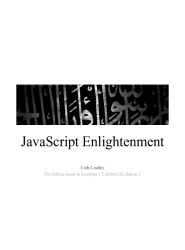Advanced javascript
This book is not about JavaScript design patterns or implementing an object-oriented paradigm with JavaScript code. It was not written to distinguish the good features of the JavaScript language from the bad. It is not meant to be a complete reference guide. It is not targeted at people new to programming or those completely new to JavaScript. Nor is this a cookbook of JavaScript recipes. Those books have been written.
Table of contents
- Introduction
- Why JavaScript
- More code, less words
- Color-coding Conventions
- JavaScript Objects
- Creating objects
- JavaScript constructors construct and return object instances
- The JavaScript native/built-in object constructors
- Instantiating constructors using the new operator
- The primitive values null, undefined, 'string', , true, and false are not objects
- How primitive values are stored/copied in JavaScript
- Primitive values are equal by value
- The string, number, and boolean primitive values act like objects when used like objects
- Complex (aka composite) values
- How complex values are stored/copied in JavaScript
- Complex objects are equal by reference
- Complex objects have dynamic properties
- The typeof operator used on primitive and complex values
- Dynamic Properties allow for mutable objects
- All constructor instances have constructor properties that point to their constructor function
- Verify that an object is an instance of a particular constructor function
- An instance created from a constructor can have its own independent properties (aka instance properties)
- The semantics between 'JavaScript objects' vs 'Object() objects'
- Chapter - Working with Objects and Properties
- Complex objects can contain most of the JavaScript values as properties
- Encapsulating complex objects in a programmatically beneficial way
- Getting/setting/updating an object's properties using dot notation or bracket notation
- Deleting object properties
- How references to object properties are resolved
- Using has Own Property, verify that an object property is not from the prototype chain
- Checking if an object contains a given property using the in operator
- Enumerate (loop over) an object’s properties using the for in loop
- Host objects vs native objects
- Chapter - Object()
- Conceptual overview of using Object() objects
- Chapter - Function()
- Conceptual overview of using Function() objects
- Function() parameters
- Function() properties and methods
- Function object instance properties and methods
- Functions always return a value
- Functions are first-class citizens (not just syntax, but values)
- Passing parameters to a function
- The argument scallee property
- Redefining function parameters
- Anonymous functions
- Self-invoking function expression
- Self-invoking anonymous function statements
- Functions can be nested
- Invoking function statements before they are defined (aka function hoisting)
- A function can call itself (aka recursion)
- Conceptual overview of the prototype chain
- Why care about the prototype property?
- Prototype is standard on all Function() instances
- The default prototype property is an Object() object
- Last stop in the prototype chain is Object prototype
- The prototype chain returns the first property match it finds in the chain
| Size : | 1,568.05 Kb |
| File type : | |
| Downloads: | 6169 |
| Created: | 2017-09-09 |
Warning: Trying to access array offset on false in /home/tutovnfz/public_html/article.php on line 233
Others javascript Tutorials
Learning Three.js: The JavaScript 3D Library for WebGL
Mastering JavaScript High Performance
Others related eBooks about Advanced javascript
JavaScript tutorial for professionalsDownload free JavaScript tutorial course in PDF, training file in 106 chapters and 490 pages. Free unaffiliated ebook created from Stack OverFlow contributor....
Designing Scalable JavaScript ApplicationsIf you've ever written a non-trivial JavaScript application, you know that creating a code..., download free JavaScript tutorial in PDF (134 pages) created by Emmit Scott ....
An Introduction to ReactJSReact is a JavaScript framework. Using the framework is as simple as including a JavaScript file in our HTML and using the React exports in our application's JavaScript. With this tutorial, we're starting out at the beginning. Let's look at what React is and what makes it tick. We'll discuss why we...
AngularJS EssentialsThis book is a practical guide filled with real-world examples that will help you discover..., download free Angular tutorial in PDF (180 pages) created by Rodrigo Branas ....
JQuery tutorial for professionalsDownload free JQuery tutorial course in PDF, training file in 18 chapters and 67 pages. Free unaffiliated ebook created from Stack OverFlow contributor....
The React Beginner's HandbookDownload free course The React Beginner's Handbook, pdf file on 40 pages by Flavio Copes....
Download ASP.NET tutorial in PDFDownload free ASP.NET tutorial course in PDF, training file in 31 chapters and 97 pages. Free unaffiliated ebook created from Stack OverFlow contributor....
Tutorial XML and DOM in PDFDownload free course Learning basic XML DOM, PDF ebook under 28 pages for beginners....
Introduction to JavaScript in PDFThis tutorial provides an overview of Javascript programming language, it's a training document course in PDF under 34 pages designated to beginners....
The Vue.js HandbookVue.js is a very impressive project. It's a very popular JavaScript framework, one that's ..., download free Vue.js tutorial in PDF (122 pages) created by ....
